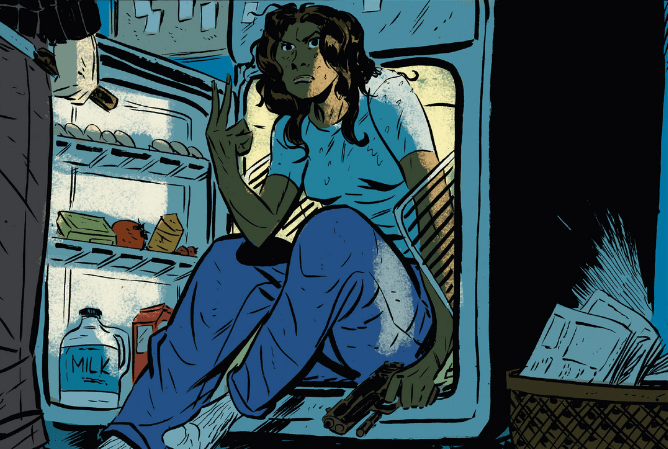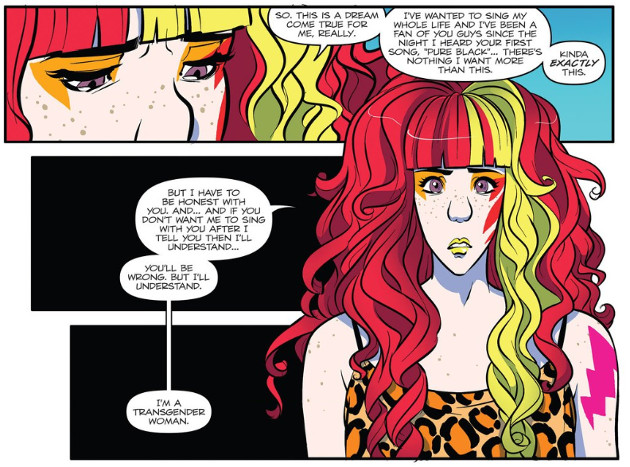The first comic I can recall writing a formal review of, roughly eleven years ago, was a collected edition of Alan Moore and David Lloyd’s’ V for Vendetta. The edition I was working from included a foreword by Lloyd originally written in 1990, describing a recent visit to a pub where the news was eschewed for soap operas and quiz shows until it couldn’t be ignored any longer, giving way instead to pop music. V for Vendetta, Lloyd concludes by saying, is for people who don’t switch off the news.When I wrote about it during George W. Bush’s second term in office, I took it a step further by saying that it was for people on the verge of turning off the news because they could no longer deal with it. It was a condition I felt close to then and one I feel especially consumed by now in the wake of not only the shooting deaths of fifty patrons of an Orlando, Florida gay club, but the converging forces of violence, institutional prejudice, and purposefully bigoted legislation that assail the LBGTQIA community with specific focus on transgender people like myself.
V for Vendetta postulated a dystopian post-nuclear future for the United Kingdom that had capitulated to fascism in such alarming ways that the only oppositional force left was a ruthless terrorist who took up the image of Catholic anti-monarchist Guy Fawkes in order to wage a campaign of insurgent violence with the end goal of smashing the state. There are no heroes in V for Vendetta. It’s perhaps the sharpest and bleakest of Moore’s motif of deconstruction of the era pitting the extremes of fascism and anarchy against each other. While Lloyd prefers to place the emphasis of the inspiration for V for Vendetta on the conditions of 30s Germany that lead to the rise of the Nazi party, it’s inarguable that it drew equally from the political climate of the Thatcher lead administration they originally produced it under. Plot details like the detention and extermination of HIV patients, the LGBTQIA community, and racial minorities were culled from comments by politicians and the right wing media of the day as much as Nazi doctrine.

Through both reprints of existing work like V for Vendetta and commissioning new comics, the early work of what would become the Vertigo imprint was deeply informed by resistance to Thatcherite ideology by the artists of the era, reaching an apotheosis in the Fear Machine arc of Hellblazer by Jamie Delano with Mark Buckingham and Richard Piers Rayner that foregrounded the policies designed to marginalize the Romani and Irish Traveller population in the UK. In considering the sea change brought about by Karen Berger’s legendary recruitment drive of UK talent, it has to be recognized that she created a space that allowed for passionately political work responding to the most urgent issues of the time and put an end to the Comics Code Authority.
As a wave of right wing resentment sweeps across the western world and intersects with the global campaign of terror spearheaded by ISIL, the industry is faced with the most urgent need for bravely political work since then on a number of issues including racial justice, islamophobia, LBGTQIA civil rights, and feminism. What’s changed however is that unlike the hero’s welcome that the likes of Maus, Watchmen, and The Dark Knight Returns received in 1986, the industry has proven remarkably resistant to making space for the voices most needed to tackle these subjects and, in many cases, recognize the primacy of those issues.
It’s a major facet of the current, ambivalent reality that Image publisher Eric Stephenson outlined in his speech to retailers at ComicsPro 2016 in February by contrasting the explosion of creativity from new voices with a nearly universal malaise felt by creators new and old alike. Stephenson, understandably, focused on the economics of the industry and the specific vice of bad business practices in the direct market that prioritize short term gains to the detriment of the long term health of the industry, but we stand on a much greater precipice than the risks presented by incentive covers and constant renumbering.
We’re in the midst of a generational shift prompting a calling into account of the exclusion of female, LBGTQIA, and POC voices that has persisted since the collapse of the CCA that enforced provisions designed to exclude them as examined by Saladin Ahmed in 2014. The wave of talent that crested in the mid to late 1980s was almost exclusively white and male, a reality that has changed little in the intervening years. A critical reappraisal of that era has been underway since Gail Simone’s Women in the Refrigerator polemic at the latest, and isn’t going away any time soon as the incoming generation of creators and critics from a diverse range of marginalized groups demand to be heard.

Even when much welcome change occurs like the hiring of Ta-Nehisi Coates and Brian Stelfreeze to revitalize Black Panther, the major publishers are slow to metabolize the perspective they bring. It’s a fact clearly evinced by the e-mails in which Coates, the foremost writer on the contemporary black condition, cautioned his peers at Marvel against killing off War Machine in the Civil War II event to no avail. It’s a pattern that has repeated itself numerous times over the last year alone as major publishers actively court readers from traditionally excluded groups and, in most cases, reject their critiques when those attempts misfire.
Marvel, as a company, actively sought to leverage the symbolism of elevating a black Captain America in Sam Wilson while trivializing the surrogacy that jewish readers have long felt for Steve Rogers when Nick Spencer, the same writer who penned Sam Wilson’s ascendancy, had the original Captain America reveal himself to be a sleeper agent of nazi-aligned Hydra. It’s a hypocrisy that has run deep in recent months as editor in chief Axel Alonso refused to categorize Angela Queen of Hel’s eponymous heroine as queer despite being in an explicitly romantic relationship with a trans woman, only to seek a GLAAD media award for that depiction shortly thereafter. It’s a hypocrisy hardly exclusive to Marvel as Image used rainbows to promote themselves to LBGTQIA readers last year while refusing to publicly answer criticism for the unexamined transmisogyny in James Robinson and Greg Hinkle’s Airboy. That criticism eventually resulted in the abandonment of the rainbow imagery and a public apology by Robinson issued to GLAAD.
As these and other pressing issues, most notably the continued employment of well documented abusers and harassers by almost every notable publisher, continue to weigh on readers and creators alike, instead of stifling or deterring the publication of the most desperately needed work, it’s causing a fragmentation of the industry and a pivot away from traditional publishers and distributors by creators and entrepreneurs fed up with inaction and broken promises.
Perhaps leading the charge is Iron Circus Comics publisher Spike Trotman, who, after several spectacularly successful Kickstarter campaigns, has begun courting large scale distributors to accomplish an end run around the Diamond monopoly to support a wide range of new titles. Former DC editor Janelle Asselin launched a POC and LBGTQIA focused romance anthology as a digital exclusive before transitioning to a successfully backed Kickstarter campaign for a print edition fulfilled by Oni Press. Black Mask and Aftershock have also entered the fray, with Boom Studios, IDW, and Dynamite innovating both their licensed and creator owned offerings to give voice to queer, female, and LBGTQIA creators. Dynamite is particularly notable for taking the unprecedented step in hiring Gail Simone and Nicola Scott to revamp their female lead titles and handpick their creative teams.
There’s no denying that watershed moments are happening throughout the industry as highlighted by the renaissance that Sophie Campbell’s career has received since she came out publicly as transgender, first by joining Kelly Thompson on Jem and the Holograms to codify Kimber and Stormer’s relationship as romantic and creating a new transgender character named Blaze, then receiving brand new editions of Wet Moon and Shadoweyes from Oni and Iron Circus respectively.

It’s also evident in the rise of Kate Leth, an outspoken advocate for LBGTQIA issues and bisexual visibility, who left her mark on Adventure Time, Bravest Warriors, and Edward Scissorhands before partnering with Brittany Williams to carve out a distinctly queer space at Marvel on Patsy Walker AKA Hellcat at Marvel. If anything, victories like these and David F. Walker’s achievements with Sanford Green and Lee Loughridge on Powerman and Ironfist or Ramon Villalobos and Tamra Bonvillain on Nighthawk are made more powerful by setbacks elsewhere, but they do nothing to exculpate the industry for those failures.
The underlying truth is that the vast majority of those in positions of power in the industry view the complex network of issues shorthanded into “diversity” as not much more than the product of entitlement, treating it more or less like a bourgeois affectation. These are, to return to David Lloyd’s twenty six year old observation, people who turn off the news. They fail to understand that the desire for a broader range of voices representing overlapping races, genders, sexualities, and classes are coming from people who face a complex calculus of survival every time they want to do something as basic as go out for a pint, which is more or less all anyone who went to Pulse on the night of June 11th wanted. Likewise, the current generation of creators and the reading public they represent aren’t asking for anything more than the opportunity that the likes of Moore and Lloyd were given to transmute their viewpoint into art and participate in the public discourse.
The shockwaves rippling through the industry are not going to subside and the fragmentation of publication and distribution will continue with the brunt of the economic, emotional, and physical impact being felt by the most vulnerable participants, but the severity can be lessened if the powers that be choose to stop, listen, and take action in meaningful ways.

[…] Graphic Novel Network – Crown on the Ground / Life During Wartime – A great […]
LikeLike